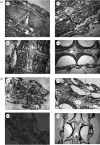Ocean acidification may increase calcification rates, but at a cost
- PMID: 18460426
- PMCID: PMC2587798
- DOI: 10.1098/rspb.2008.0343
Ocean acidification may increase calcification rates, but at a cost
Abstract
Ocean acidification is the lowering of pH in the oceans as a result of increasing uptake of atmospheric carbon dioxide. Carbon dioxide is entering the oceans at a greater rate than ever before, reducing the ocean's natural buffering capacity and lowering pH. Previous work on the biological consequences of ocean acidification has suggested that calcification and metabolic processes are compromised in acidified seawater. By contrast, here we show, using the ophiuroid brittlestar Amphiura filiformis as a model calcifying organism, that some organisms can increase the rates of many of their biological processes (in this case, metabolism and the ability to calcify to compensate for increased seawater acidity). However, this upregulation of metabolism and calcification, potentially ameliorating some of the effects of increased acidity comes at a substantial cost (muscle wastage) and is therefore unlikely to be sustainable in the long term.
Figures




Similar articles
-
Energy metabolism and regeneration are impaired by seawater acidification in the infaunal brittlestar Amphiura filiformis.J Exp Biol. 2014 Jul 1;217(Pt 13):2411-21. doi: 10.1242/jeb.100024. Epub 2014 Apr 15. J Exp Biol. 2014. PMID: 24737772
-
Coral calcifying fluid pH dictates response to ocean acidification.Sci Rep. 2014 Jun 6;4:5207. doi: 10.1038/srep05207. Sci Rep. 2014. PMID: 24903088 Free PMC article.
-
Impact of seawater acidification on pH at the tissue-skeleton interface and calcification in reef corals.Proc Natl Acad Sci U S A. 2013 Jan 29;110(5):1634-9. doi: 10.1073/pnas.1216153110. Epub 2012 Dec 31. Proc Natl Acad Sci U S A. 2013. PMID: 23277567 Free PMC article.
-
Ocean acidification: the other CO2 problem.Ann Rev Mar Sci. 2009;1:169-92. doi: 10.1146/annurev.marine.010908.163834. Ann Rev Mar Sci. 2009. PMID: 21141034 Review.
-
Impact of near-future ocean acidification on echinoderms.Ecotoxicology. 2010 Mar;19(3):449-62. doi: 10.1007/s10646-010-0463-6. Epub 2010 Feb 5. Ecotoxicology. 2010. PMID: 20130988 Review.
Cited by
-
Ocean warming and acidification adjust inter- and intra-specific variability in the functional trait expression of polar invertebrates.Sci Rep. 2024 Jul 1;14(1):14985. doi: 10.1038/s41598-024-65808-5. Sci Rep. 2024. PMID: 38951669 Free PMC article.
-
Direct, carryover, and maternal effects of ocean acidification on snow crab embryos and larvae.PLoS One. 2023 Oct 18;18(10):e0276360. doi: 10.1371/journal.pone.0276360. eCollection 2023. PLoS One. 2023. PMID: 37851644 Free PMC article.
-
Increased Food Resources Help Eastern Oyster Mitigate the Negative Impacts of Coastal Acidification.Animals (Basel). 2023 Mar 25;13(7):1161. doi: 10.3390/ani13071161. Animals (Basel). 2023. PMID: 37048417 Free PMC article.
-
Proteomic and Transcriptomic Responses Enable Clams to Correct the pH of Calcifying Fluids and Sustain Biomineralization in Acidified Environments.Int J Mol Sci. 2022 Dec 16;23(24):16066. doi: 10.3390/ijms232416066. Int J Mol Sci. 2022. PMID: 36555707 Free PMC article.
-
A Transcriptomic Analysis of Phenotypic Plasticity in Crassostrea virginica Larvae under Experimental Acidification.Genes (Basel). 2022 Aug 25;13(9):1529. doi: 10.3390/genes13091529. Genes (Basel). 2022. PMID: 36140697 Free PMC article.
References
-
- Bannister R, McGonnell I.M, Graham A, Thorndyke M.C, Beesley P.W. Afuni, a novel transforming growth factor-β gene is involved in arm regeneration by the brittle star Amphiura filiformis. Dev. Genes Evol. 2005;215:393–401. doi:10.1007/s00427-005-0487-8 - DOI - PubMed
-
- Bowmer T. Reproduction in Amphiura filiformis (Echinodermata, Ophiuroidea)—seasonality in gonad development. Mar. Biol. (Berl.) 1982;69:281–290. doi:10.1007/BF00397493 - DOI
-
- Bowmer T, Keegan B.F. Field survey of the occurrence and significance of regeneration in Amphiura filiformis (Echinodermata, Ophiuroidea) from Galway Bay, West-Coast of Ireland. Mar. Biol. (Berl.) 1983;74:65–71. doi:10.1007/BF00394276 - DOI
-
- Caldeira K, Wickett M.E. Anthropogenic carbon and ocean pH. Nature. 2003;425:365. doi:10.1038/425365a - DOI - PubMed
-
- Candia Carnevali M.D, Galassi S, Bonasoro F, Patruno M, Thorndyke M.C. Regenerative response and endocrine disrupters in crinoid echinoderms: arm regeneration in Antedon mediterranea after experimental exposure to polychlorinated biphenyls. J. Exp. Biol. 2001;204:835–842. - PubMed
Publication types
MeSH terms
Substances
LinkOut - more resources
Full Text Sources
Other Literature Sources
Miscellaneous


